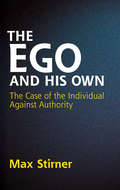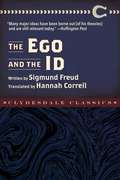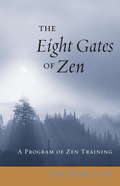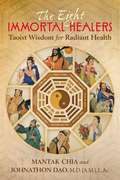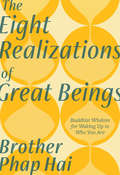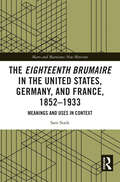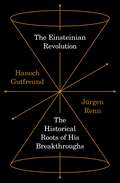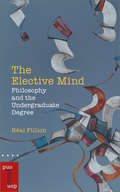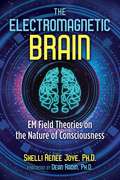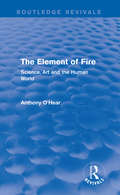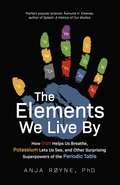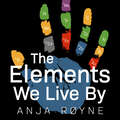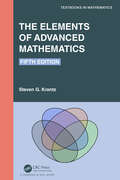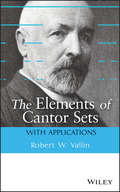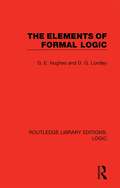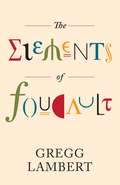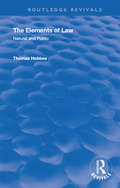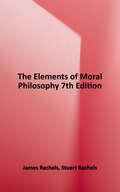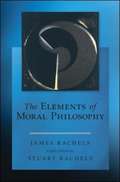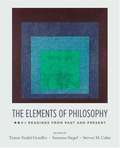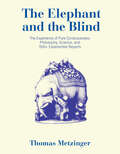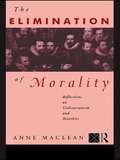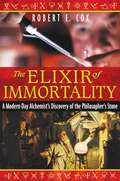- Table View
- List View
The Ego and His Own: The Case of the Individual Against Authority (Radical Thinkers Ser. #8)
by Max Stirner Steven T. Byington James J. MartinCredited with influencing the philosophies of Nietzsche and Ayn Rand and the development of libertarianism and existentialism, this prophetic 1844 work challenges the very notion of a common good as the driving force of civilization. Stirner chronicles the battle of the individual against the collective to show how the latter invariably leads to oppression.
The Ego and the Id (Complete Psychological Works Of Sigmund Freud Ser. #0)
by Sigmund Freud“Many major ideas have been borne out [of his theories] and are still relevant today.” —Huffington Post One of famed psychoanalyst Sigmund Freud’s most prominent ideas was that of the id, the ego, and the super-ego—the three main factors behind the workings of the human mind. Freud claimed these components of the human psyche controlled all processes of personality, behaviors, and traits in a person. The Id was a person’s most basic and impulsive instincts—the ones that feed into our deepest desires and physical needs. The Super-Ego was the opposite of the id. This component controlled our highest morals and standards, operating through our conscience and making us desire to be our most ideal-selves. The piece in the middle is the Ego. The ego mediates between the id and realities of the world around us, while being supervised (and guilted) by the super-ego. In this new edition of his book, The Ego and the Id, Sigmund Freud delves deeper into the concepts of the human mind and the results of the conflicts and workings between them.
The Egyptian Book of the Dead: The Complete Papyrus of Ani (Mini Albums Ser.)
by E.A. Wallis BudgeA New Edition of the Ancient Egyptian Book of the Dead, Perfect for History Buffs, Budding Archaeologists, or Mythology Enthusiasts! The Egyptian Book of the Dead is unquestionably one of the most influential books in all history. Containing the ancient ritual to be performed for the dead with detailed instructions for the behavior of the soul in the afterlife, it served as the most important repository of religious authority for some three thousand years. Chapters were carved on the pyramids of the ancient 5th Dynasty, texts were written in papyrus, and selections were painted on mummy cases well into the Christian era. In a certain sense, it represented all history and research of Egyptian civilization. In the year 1888, Dr. E. A. Wallis Budge, then purchasing agent for the British Museum, followed rumors he heard of a spectacular archaeological find in Upper Egypt, and found in an 18th Dynasty tomb near Luxor a perfectly preserved papyrus scroll. It was a copy of the Egyptian Book of the Dead, written around 1500 B.C. for Ani, Royal Scribe of Thebes, Overseer of the Granaries of the Lords of Abydos, and Scribe of the Offerings of the Lords of Thebes. This Papyrus of Ani is presented here by Dr. Budge. Reproduced in full are a clear copy of the Egyptian hieroglyphs, an interlinear transliteration of their sounds (as reconstructed), a word-for-word translation, and separately a complete smooth translation. All this is preceded by an original introduction of more than 150 pages. This classic material combined with a brand-new foreword by Dr. Foy Scalf of Chicago University gives the reader has a unique opportunity to experience all the fascinating aspects of The Egyptian Book of the Dead.
The Eight Gates of Zen: A Program of Zen Training
by John Daido LooriThis accessible introduction to the philosophy and practice of Zen Buddhism includes a program of study that encompasses practically every aspect of life. The American Zen teacher John Daido Loori shows us that Zen practice should include not only meditation, the study of Zen literature and liturgy, and moral and ethical action, but should also manifest in work, artistic, and everyday activities. The Eight Gates are:Zazen, a type of meditation described as "sitting Zen"Face-to-face meetings between teacher and studentAcademic study of the sutras related to Zen training, other schools of Buddhism, Buddhist history, psychology, and philosophyZen rites and rituals and their meaningThe moral and ethical requirements set in the Buddhist PreceptsArt practice as an extension of Zen practiceBody practice as an extension of Zen practiceWork as an active function of zazenBeautifully illustrated with Loori's own photographs, this edition also includes a new introduction and an updated reading list.
The Eight Immortal Healers: Taoist Wisdom for Radiant Health
by Mantak Chia Johnathon DaoA detailed guide to restoring the eight foundational areas of health• Explains how each of legendary Taoist masters known as the Eight Immortals has a specific area of health as the focus of his or her teachings• Offers practices, techniques and guidelines for each of the Eight Immortal Healer teachings, including the important roles of oxygen and water in the body, nutrition, detoxification, exercise, energy work, emotional pollution, and spiritual hygieneThe Eight Immortals are a group of legendary ancient Taoist masters, each associated with a specific area of health or a powerful healing technique. These eight disciplines can bestow vibrant health and well-being and provide the antidote to the stresses, ailments, degenerative diseases, and toxins of modern life.In this guide to the healing practices of the Eight Immortals, Master Mantak Chia and Johnathon Dao share the legends of each Immortal teacher and detail the many ways to apply their wisdom through nutrition, exercises, supplements, detoxification methods, spiritual practices, and energy work. They explain how the first Immortal, born during the 8th century AD, is associated with oxygen, considered in the Taoist healing perspective as the body’s primary nutrient. They discuss how oxygen deficiency is the main culprit in cancer and virus and provide a number of oxygen therapies including the use of hydrogen peroxide and deep breathing to stimulate the metabolism and immune system. The second Immortal Healer centers on water, and the authors explain how chronic dehydration can lead to a host of ailments and offer advice for rehydrating. The other teachings of the Immortal Healers include Nutrition, with guidance on supplements, superfoods, toxic foods, and daily meals; Detoxification, with detailed guidelines for cleansing the body’s organs and glands; Avoiding environmental poisons, with advice on vaccines, dental amalgam fillings, sunscreen, chemotherapy, fluoride, and pesticides; Exercise, with step-by-step instructions for Inner Alchemy practices, yoga, and breathing techniques; Maintenance of the energy body, through acupuncture, chi kung healing, magnet therapy, and photon sound beams; and Emotional pollution and spiritual hygiene, with a wealth of practices for balancing the emotional body and staying connected to Source, including forgiveness, meditation, and karmic yoga.By following these Eight Immortal Healers, you can take control of your health, remove the root causes of the chronic ailments that inhibit well-being and longevity, and choose to live life to the fullest in happiness and radiant health.
The Eight Realizations of Great Beings: Essential Buddhist Wisdom for Waking Up to Who You Are
by Brother Phap HaiA pithy guide to the Buddha's instructions to unlock the powerful insights that make us "great"—by wise, warm, and humorous Brother Phap Hai, the most senior Australian Dharma teacher ordained by Thich Nhat Hanh In this essential sutra for sincere practitioners, the Buddha says, "If you would like to be enlightened, take on these eight subjects for meditation and apply their corresponding insights to your daily life." Brother Phap Hai's lively, down-to-earth explanation of spirituality's original self-help manual makes this book a must-read for all seeking inspiration on the path of self-realization and compassion. Beginning with a brief historical overview of the sutra's origins, Brother Phap Hai explores each of the eight realizations and shares a story in each chapter from his own journey to become a monk himself.Ordaining as a Buddhist monk in 1997 while still in his twenties, Brother Phap Hai has been practicing mindfulness on a daily basis for much of his adult life. Zen Master Thich Nhat Hanh authorized him to teach in 2003, and since then, he has guided and mentored thousands of students in meditation. Brother Phap Hai calls the Buddha's Discourse on the Eight Realizations of Great Beings his "'Desert Island Sutra' because it distills the essence of the Buddhist path." In his words, it is everything you need in a practical meditation manual, "a very structured exposition of realizing the entirety of the Buddhist path for yourself."
The Eighteenth Brumaire in the United States, Germany, and France, 1852–1933: Meanings and Uses in Context (Marx and Marxisms)
by Sam StarkThe Eighteenth Brumaire in the United States, Germany, and France, 1852–1933 is the first extended political history of Karl Marx’s seminal text.Written largely in an engaging narrative form that centers political actors engaging with the text, the book uses published and archival sources to reconstruct the contexts of editions in three languages over eight decades. Stark begins with a new interpretation of the origins of the Brumaire in a context of arguments among revolutionaries in exile, then surveys the main features of its republication in Germany and initial reception (1860–870), its uptake by socialists in Germany and France (1872–892), its status in Germany, France, and the United States before the First World War, and its fate in the Weimar Republic (1918–933).Convincingly proving that the history of the Eighteenth Brumaire should matter for our understanding of Marx today, this book will be fresh for specialists but accessible for diligent students and others without any special background.
The Einsteinian Revolution: The Historical Roots of His Breakthroughs
by Hanoch Gutfreund Jürgen RennHow the Einsteinian revolution can be understood as the result of a long-term evolution of science The revolution that emerged from Albert Einstein’s work in the early twentieth century transformed our understanding of space, time, motion, gravity, matter, and radiation. Beginning with Einstein’s miracle year of 1905 and continuing through his development of the theory of general relativity, Einstein spurred a revolution that continues to reverberate in modern-day physics. In The Einsteinian Revolution, Hanoch Gutfreund and Jürgen Renn trace the century-long transformation of classical physics and argue that the revolution begun by Einstein was in fact the result of a long-term evolution. Describing the origins and context of Einstein’s innovative research, Gutfreund and Renn work to dispel the popular myth of Einstein as a lone genius who brought about a revolution in physics through the power of his own pure thought. We can only understand the birth of modern physics, they say, if we understand the long history of the evolution of knowledge.Gutfreund and Renn outline the essential structures of the knowledge system of classical physics on which Einstein drew. Examining Einstein’s discoveries from 1905 onward, they describe the process by which new concepts arose and the basis of modern physics emerged. These transformations continued, eventually resulting in the establishment of quantum physics and general relativity as the two major conceptual frameworks of modern physics—and its two unreconciled theoretical approaches. Gutfreund and Renn note that Einstein was dissatisfied with this conceptual dichotomy and began a search for a unified understanding of physics—a quest that continued for the rest of his life.
The Elective Mind: Philosophy and the Undergraduate Degree (Philosophica)
by Réal FillionThis book discusses the relevance of philosophy courses within the undergraduate curriculum as integral to the self-formation that is at the heart of a liberal education. The objective is to provide a historically layered view of what it can still mean to study for its own sake. The elective university classroom is important because the course of study is chosen out of personal interest and enthusiasm, as opposed to being primarily governed by predetermined disciplinary objectives. It engages the student’s mind directly and freely, and counters the overly specialized minds favoured by the contemporary university as well as the commodification of its degrees. The discussion builds on the distinction put forward by Raymond Williams between a dominant culture (in this case, university study as contributing to research and/or marketable degrees) and alternative and/or oppositional cultures that have both residual and emergent dimensions. The elective stream of university study is treated as alternative and oppositional to the dominant culture. The elective university classroom is examined as a combination of a classroom, students, texts, and professors. Each element is explored in terms of its alternative/residual significance as illustrated through the history of philosophy: the classroom and students through the life and death of Socrates; texts through the origins of the university in medieval scholasticism; the professor in the Humboldtian reform of the university at the beginning of the nineteenth century in Berlin. Published in English.
The Electromagnetic Brain: EM Field Theories on the Nature of Consciousness
by Shelli Renée JoyeAn exploration of cutting-edge theories on the electromagnetic basis of consciousness • Details, in nontechnical terms, 12 credible theories, each published by prominent professionals with extensive scientific credentials, that describe how electromagnetic fields may be the basis for consciousness • Examines practical applications of electromagnetic-consciousness theory, including the use of contemporary brain stimulation devices to modify and enhance consciousness • Explores the work of William Köhler, Susan Pockett, Johnjoe McFadden, Rupert Sheldrake, Ervin Laszlo, William Tiller, Harold Saxton Burr, Sir Roger Penrose, Stuart Hameroff, Mari Jibu, Kunio Yasue, Karl Pribram, Alfred North Whitehead, and James Clerk Maxwell, as well as the author's own theories In this scientific exploration of the origin of consciousness, Shelli Renée Joye, Ph.D., explores 12 credible theories, each published by prominent professionals with extensive scientific credentials, that describe how electricity in the form of electromagnetic fields is the living consciousness that runs through the brain. Each of these theories supports the idea that the electromagnetic field itself is the basis of consciousness and that this source of consciousness peers out into the space-time universe through our human sensory systems, flowing with awareness throughout the bloodstream and nervous system. Following her exploration of electromagnetic-consciousness theories, Joye then examines practical applications, describing how electric fields might be manipulated and controlled to modify and enhance the operation of consciousness in the human brain. She explores the use of contemporary brain stimulation devices that offer benefits such as decreased addiction cravings and anxiety, reduced depression and chronic pain, enhanced mathematical abilities, accelerated learning, and greater insight during mindfulness meditation. Revealing the cutting edge of consciousness studies, Joye shows that consciousness is not an isolated function of the individual brain but is connected to the larger electromagnetic field that not only encompasses the entire physical universe but also is deeply involved in the creation of matter and the material world.
The Element of Fire: Science, Art and the Human World (Routledge Revivals)
by Anthony O'HearFirst published in 1988, the aim of this book can be stated in Nietzsche’s words: ‘To look at science from the perspective of the artist, but at art from that of life’. The title contests the notions that science alone can provide us with the most objective truth about the world, and that artistic endeavour can produce nothing more valuable than entertainment. O’Hear argues that art and the study of art are not indispensable aspects of human life, and that this is equally as important as the investigation of the natural world.
The Elements We Live By: How Iron Helps Us Breathe, Potassium Lets Us See, and Other Surprising Superpowers of the Periodic Table
by Anja RøyneWINNER OF THE 2018 BRAGE PRIZE'[T]his lovely book. An enjoyable sweep through topics ranging from respiration to space exploration -solid science presented in an engagingly human way' Andrew Crumey, author of The Great Chain of Unbeing'Perfect popular science . . . not just a well-written story about the elements, but a book about being human in the world today'Åsmund H. Eikenes, author of Splash: A History of Our BodiesWe all know that we depend on elements for survival - from oxygen in the air we breathe to carbon in the molecular structures of all living things. But we seldom appreciate how, say, phosphorus holds our DNA together or how potassium powers our optic nerves enabling us to see.Physicist and award-winning author Anja Røyne takes us on an astonishing journey through chemistry and physics, introducing the building blocks from which we humans - and everything else in the world - are made. Not only does Røyne explain why our bodies need iron, phosphorus, silicon, potassium and many more elements in just the right amounts in order to function, she also shows us where in the world these precious elements are found (some of them in limited and quickly depleting quantities).Røyne helps us understand how precariously balanced our lives - and ways of living - really are, and to appreciate little known and generally unsung heroes of the periodic table in an entirely new light.
The Elements We Live By: How Iron Helps Us Breathe, Potassium Lets Us See, and Other Surprising Superpowers of the Periodic Table
by Anja RøyneWINNER OF THE 2018 BRAGE PRIZE'[T]his lovely book. An enjoyable sweep through topics ranging from respiration to space exploration -solid science presented in an engagingly human way' Andrew Crumey, author of The Great Chain of Unbeing'Perfect popular science . . . not just a well-written story about the elements, but a book about being human in the world today'Åsmund H. Eikenes, author of Splash: A History of Our BodiesWe all know that we depend on elements for survival - from oxygen in the air we breathe to carbon in the molecular structures of all living things. But we seldom appreciate how, say, phosphorus holds our DNA together or how potassium powers our optic nerves enabling us to see.Physicist and award-winning author Anja Røyne takes us on an astonishing journey through chemistry and physics, introducing the building blocks from which we humans - and everything else in the world - are made. Not only does Røyne explain why our bodies need iron, phosphorus, silicon, potassium and many more elements in just the right amounts in order to function, she also shows us where in the world these precious elements are found (some of them in limited and quickly depleting quantities).Røyne helps us understand how precariously balanced our lives - and ways of living - really are, and to appreciate little known and generally unsung heroes of the periodic table in an entirely new light.
The Elements of Advanced Mathematics (Textbooks in Mathematics)
by Steven G. KrantzThis book has enjoyed considerable use and appreciation during its first four editions. With hundreds of students having learned out of early editions, the author continues to find ways to modernize and maintain a unique presentation. What sets the book apart is the excellent writing style, exposition, and unique and thorough sets of exercises. This edition offers a more instructive preface to assist instructors on developing the course they prefer. The prerequisites are more explicit and provide a roadmap for the course. Sample syllabi are included. As would be expected in a fifth edition, the overall content and structure of the book are sound. This new edition offers a more organized treatment of axiomatics. Throughout the book, there is a more careful and detailed treatment of the axioms of set theory. The rules of inference are more carefully elucidated. Additional new features include: An emphasis on the art of proof. Enhanced number theory chapter presents some easily accessible but still-unsolved problems. These include the Goldbach conjecture, the twin prime conjecture, and so forth. The discussion of equivalence relations is revised to present reflexivity, symmetry, and transitivity before we define equivalence relations. The discussion of the RSA cryptosystem in Chapter 8 is expanded. The author introduces groups much earlier. Coverage of group theory, formerly in Chapter 11, has been moved up; this is an incisive example of an axiomatic theory. Recognizing new ideas, the author has enhanced the overall presentation to create a fifth edition of this classic and widely-used textbook.
The Elements of Cantor Sets--with Applications
by Robert W. VallinA systematic and integrated approach to Cantor Sets and their applications to various branches of mathematics The Elements of Cantor Sets: With Applications features a thorough introduction to Cantor Sets and applies these sets as a bridge between real analysis, probability, topology, and algebra. The author fills a gap in the current literature by providing an introductory and integrated perspective, thereby preparing readers for further study and building a deeper understanding of analysis, topology, set theory, number theory, and algebra. The Elements of Cantor Sets provides coverage of: Basic definitions and background theorems as well as comprehensive mathematical details A biography of Georg Ferdinand Ludwig Philipp Cantor, one of the most significant mathematicians of the last century Chapter coverage of fractals and self-similar sets, sums of Cantor Sets, the role of Cantor Sets in creating pathological functions, p-adic numbers, and several generalizations of Cantor Sets A wide spectrum of topics from measure theory to the Monty Hall Problem An ideal text for courses in real analysis, topology, algebra, and set theory for undergraduate and graduate-level courses within mathematics, computer science, engineering, and physics departments, The Elements of Cantor Sets is also appropriate as a useful reference for researchers and secondary mathematics education majors.
The Elements of Formal Logic (Routledge Library Editions: Logic)
by G. E. Hughes D. G. LondeyOriginally published in 1965. This is a textbook of modern deductive logic, designed for beginners but leading further into the heart of the subject than most other books of the kind. The fields covered are the Propositional Calculus, the more elementary parts of the Predicate Calculus, and Syllogistic Logic treated from a modern point of view. In each of the systems discussed the main emphases are on Decision Procedures and Axiomatisation, and the material is presented with as much formal rigour as is compatible with clarity of exposition. The techniques used are not only described but given a theoretical justification. Proofs of Consistency, Completeness and Independence are set out in detail. The fundamental characteristics of the various systems studies, and their relations to each other are established by meta-logical proofs, which are used freely in all sections of the book. Exercises are appended to most of the chapters, and answers are provided.
The Elements of Foucault (Posthumanities #55)
by Gregg LambertA new conceptual diagram of Foucault&’s original vision of the biopolitical order The history around the critical reception of Michel Foucault&’s published writings is troubled, according to Gregg Lambert, especially in light of the controversy surrounding his late lectures on biopolitics and neoliberal governmentality. In this book, Lambert&’s unique approach distills Foucault&’s thought into its most basic components in order to more fully understand its method and its own immanent rules of construction.The Elements of Foucault presents a critical study of Foucault&’s concept of method from the earlier History of Sexuality, Volume 1, to his later lectures. Lambert breaks down Foucault&’s post-1975 analysis of the idea of biopower into four elements: the method, the conceptual device (i.e., dispositif), the grid of intelligibility, and the notion of &“milieu.&” Taken together, these elements compose the diagram of Foucault&’s early analysis and the emergence of the neoliberal political economy. Lambert further delves into how Foucault&’s works have been used and misused over time, challenging the periodization of Foucault&’s later thought in scholarship as well as the major and most influential readings of Foucault by other contemporary philosophers—in particular Gilles Deleuze and Giorgio Agamben. The Elements of Foucault is the first generally accessible, yet rigorous and comprehensive, discussion of lectures and major published works of Foucault&’s post-1975 theory of biopower and of the major innovation of the concept of dispositif. It is also the first critical work to address the important influence of French philosopher Georges Canghuilhem on Foucault&’s thought.
The Elements of Law: Natural and Politic (Routledge Revivals)
by Thomas HobbesOriginally published in 1889, Ferdinand Tonnies published versions of two works by Thomas Hobbes. His editions of The Elements of Law: Natural and Politic and of Behemoth: or The Long Parliament were the first modern critical editions, based on manuscripts of works by Hobbes. Completed in 1640, The Elements of Law was Hobbes's first systematic political work. The book helps us see Hobbes's mind at work, for it is the first version of his later political works.
The Elements of Moral Philosophy
by Stuart Rachels James RachelsFirmly established as the standard text for undergraduate courses in ethics, James Rachels and Stuart Rachels' The Elements of Moral Philosophy introduces readers to major moral concepts and theories through eloquent explanations and compelling, thought-provoking discussions.
The Elements of Moral Philosophy 8th Edition
by Stuart Rachels James RachelsThe Elements of Moral Philosophy by James Rachels and Stuart Rachels is a best-selling text for undergraduate courses in ethics. Thirteen thought-provoking chapters introduce readers to major moral concepts and theories in philosophy through clear, understandable explanations and compelling discussions.
The Elements of Philosophy: Readings from Past and Present
by Steven M. Cahn Susanna Siegel Tamar Szabó GendlerThe Elements of Philosophy: Readings from Past and Present offers an extensive collection of classic and contemporary readings, organized topically into five main sections: Religion and Belief, Moral and Political Philosophy, Metaphysics and Epistemology, Philosophy of Mind and Language, and Life and Death. Within these broad areas, readings are arranged in clusters that address both traditional issues--such as the existence of God, justice and the state, knowledge and skepticism, and free will--and contemporary topics--including God and science, just war theory, vegetarianism, and time travel. Carefully chosen selections from a wide range of pre-20th-century philosophers are paired with writings from more than fifty leading contemporary philosophers and thinkers. The traditional philosophers represented range from Plato and Aristotle to Immanuel Kant and A. J. Ayer; the contemporary philosophers include Saul Kripke, David Lewis, Thomas Nagel, Derek Parfit, Hilary Putnam, Robert Nozick, Judith Jarvis Thomson, John Rawls, Bernard Williams, and Susan Wolf. Also included are selections from linguist Noam Chomsky, physicist Albert Einstein, and psychologist William James. Edited by a team of scholars who are also highly esteemed instructors, The Elements of Philosophy is uniquely student-friendly. A team of undergraduate philosophy majors played a central role in helping to select topics, choose readings, and identify terms likely to require clarification. In response to their suggestions, the volume includes detailed introductions to each section, explanatory footnotes that define unfamiliar terms and concepts, an extensive glossary, and a guide to further resources. A companion Instructor's Manual, available on CD, offers article summaries, suggested essay questions, reading guides, model handouts, and sample syllabi. One of the most extensive and expansive anthologies available, The Elements of Philosophy is an ideal choice for both general and targeted introductory philosophy courses.
The Elephant and the Blind: The Experience of Pure Consciousness: Philosophy, Science, and 500+ Experiential Reports
by Thomas MetzingerAn engaging and insightful journey into human consciousness.What if our goal had not been to land on Mars, but in pure consciousness? The experience of pure consciousness—what does it look like? What is the essence of human consciousness? In The Elephant and the Blind, influential philosopher Thomas Metzinger, one of the world's leading researchers on consciousness, brings together more than 500 experiential reports to offer the world's first comprehensive account of states of pure consciousness. Drawing on a large psychometric study of meditators in 57 countries, Metzinger focuses on &“pure awareness&” in meditation—the simplest form of experience there is—to illuminate the most fundamental aspects of how consciousness, the brain, and illusions of self all interact.Starting with an exploration of existential ease and ending on Bewusstseinskultur, a culture of consciousness, Metzinger explores the increasingly non-egoic experiences of silence, wakefulness, and clarity, of bodiless body-experience, ego-dissolution, and nondual awareness. From there, he assembles a big picture—the elephant in the parable, from which the book&’s title comes—of what it would take to arrive at a minimal model explanation for conscious experience and create a genuine culture of consciousness. Freeing pure awareness from new-age gurus and old religions, The Elephant and the Blind combines personal reports of pure consciousness with incisive analysis to address the whole consciousness community, from neuroscientists to artists, and its accessibility echoes the author&’s career-long commitment to widening access to philosophy itself.
The Elimination of Morality: Reflections on Utilitarianism and Bioethics
by Anne MacleanFirst published in 1993. Routledge is an imprint of Taylor & Francis, an informa company.
The Elixir of Immortality: A Modern-Day Alchemist’s Discovery of the Philosopher’s Stone
by Robert E. CoxA modern-day quest that echoes the ancient alchemists’ work to discover the elixir of life • Provides an overview of alchemical practices in the ancient world--from Europe to China • Reveals the alchemical secrets for creating this elixir in clear scientific language In 1989, while attempting to extract precious minerals from his property, a wealthy Arizonan obtained a mysterious white material that initially defied scientific attempts to identify it. After several years of testing, this substance was revealed to consist of gold and platinum--but in a form unknown to modern science. Further research showed that this powder, which had also been discovered to possess marvelous healing powers, contained monatomic forms of precious metals whose electron units had been altered to no longer display the physical, chemical, or electrical properties of the original elements. This substance, Robert Cox shows, bears eerie resemblance to the ultimate quest of the alchemists: the elixir of immortality. The mysterious material-spiritual science of alchemy was once pervasive throughout the ancient world, spanning the globe from China and India to Egypt and medieval Europe. In The Elixir of Immortality, Robert Cox reviews the alchemical lore of these traditions and the procedures each used to produce this fabulous elixir. Using his own alchemical research, Cox then reveals secrets that have been kept hidden for millennia uncovered in his own modern-day quest to rediscover this long-sought elixir of life.
The Elizabethan World Picture
by E. M. W. TillyardMy object then is to extract and expound the most ordinary beliefs about the constitution of the world as pictured in the Elizabethan age and through this exposition to help the ordinary reader to understand and to enjoy the great writers of the age. In attempting this I have incidentally brought together a number of pieces of elementary lore which I have not found assembled elsewhere. This book may actually be a convenient factual aid to the bare construing of some of Spenser or Donne or Milton.
